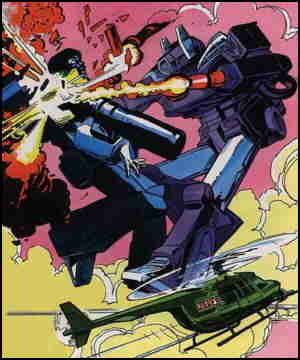
TRANSFORMERS
Original Media: Toys and Comic BooksProduced by: Hasbro and Marvel
First appeared: 1984
Please contribute to its necessary financial support.
Amazon.com or PayPal

|
TRANSFORMERSOriginal Media: Toys and Comic BooksProduced by: Hasbro and Marvel First appeared: 1984 Please contribute to its necessary financial support. Amazon.com or PayPal |
| … from various producers of cartoon story media that support them, providing more-than-ample fodder for the imaginations of children playing with the toys, there is indeed more to Transformers than the eye can encompass no matter how much manages to meet it.
Most sources say the first animated series debuted September 17, 1984 — but even in that, there's more than meets the eye, because there are also scattered reports of a few TV outlets broadcasting parts of it as much as a year earlier. If the official timetable is accurate, the Marvel Comics adaptation began cover-dated the same month as the show. Not only was Marvel present from the concept's first appearance in public — it was also there during much of the planning, with writers and editors Jim Shooter (Legion of Super Heroes), Denny O'Neil (Green Lantern/Green Arrow) and Bob Budiansky (Sleepwalker) all contributing to the development of its storyline. Budiansky became most closely associated with the concept, especially in comics, developing a great deal of Transformers continuity. His contributions include the names of several prominent characters, including Megatron, leader of the Decepticons (bad guys among Transformers). Tho Transformers are an American product, their inspiration came from a Japanese toy line based on the character Megaman, a knock-off of Hasbro's G.I. Joe (no relation). In 1983, a Microman spin-off, Microchange, featured things that could be manipulated into looking like toy robots, and in that form, Hasbro imported the idea back as Transformers. While details of the Transformers back-story may be beyond the comprehension of humans who haven't spent many hours watching them on TV and reading them in comic books, the basic scenario is reasonably simple. It starts with the distant planet Cybertron, once used by the Quintessons, a now-extinct alien species, as a planet-sized automatic factory for making robots. It continued making robots after the aliens no longer needed them. These came in a wide variety of forms (all malleable, as good Transformers should be), but they boiled down to two general types — the Autobots (led by Optimus Prime), descended from factory worker robots; and the Decepticons (led by Megatron), descended from war machines. The Decepticons invaded Earth, the Autobots opposed them, and all else flowed from there. On television, the original series ran only 13 episodes, three of which, broadcast as a mini-series, set the stage. But it was followed by Transformers: Five Faces of Darkness (1986), Beast Machines: Transformers (1999), Transformers: Galaxy Force (2005) and a couple dozen or so others. A feature-length movie was released August 8, 1986. The original comic book series ran 80 issues, ending in July, 1991, with occasional guest appearances from regular Marvel characters such as Spider-Man. Marvel also exploited the property in digest form as well as in a magazine-formatted comic, i.e., packaged like Mad magazine, and in various mini-series through 1994. Marvel also did an adaptation of the movie. In more recent years, Dreamwave Productions (also responsible for a 2003 Teenage Mutant Ninja Turtles series) took over the franchise, producing more than a dozen titles based on the property. In 2007, Transformers was re-launched, with a major live-action feature-length movie released by Paramount (Little Orphan Annie, George Pal's Puppetoons) on July 3. A sequel is planned for 2009. — DDM BACK to Don Markstein's Toonopedia™ Home Page
|
|